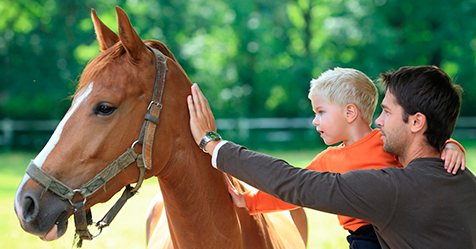Functional effects of equine therapy on riders-pacients
Equine therapy has different functional effects on the patient in their therapeutic process. In this sense, the therapist must appropriately choose the appropriate strategies to channel the therapy to the problems detected. To do this, he will select the appropriate exercises since the intimate contact of the patient’s body with the horse stimulates the patient’s different systems. In this article we will focus on the functional effects of Equine Therapy.

Table of Contents.
Functional effects on the digestive system
The constant and rhythmic movement of the pelvis greatly stimulates peristalsis of the intestine. The faster the movement (trot and canter), the more stimulation is given to the internal organs of the abdomen, which is beneficial for people who cannot walk and suffer from chronic constipation. By applying neuromuscular exercises focused on the abdominal muscles, the effect on the intestine is increased. In addition, it is proven that horseback riding increases heart rate and promotes blood circulation. The constant massage of the legs with the horse’s side stimulates their blood circulation.
Functional effects on the respiratory system
The demands on cardiac and circulatory function are much greater at gallop, which the therapist must consider when working with patients with heart problems. Joined step and jogging are used, which are relaxing movements to stimulate the circulatory system without excessively straining the heart function.
In order for breathing to regularize and deepen during riding, it is advisable to use jogging. The correct riding position encourages the opening of the shoulders, the release of the diaphragm and the lung area, favoring inspiration and expiration
Breathing Exercise Application
The application of breathing exercises and vocalization aloud, always in harmony with the horse’s rhythm, favors the regularization of breathing. That is why equine therapy is used in patients with respiratory problems such as chronic bronchitis and asthma.
Functional effects on the musculoskeletal system
Thanks to the synchrony of movements between the horse and the rider-patient, equine therapy stimulates the patient’s muscles and balance. Through therapeutic horseback riding, patients are able to stimulate and strengthen the muscles, while protecting the bones and joints.
Equine therapy also stimulates the nervous system, especially the nerves linked to the musculature as we will see later. This reduces abnormal movement patterns. Muscle development also favors the associated nervous system.
By stimulating the muscles, the relationship with these muscles and their control is also stimulated, either to contract them or to relax them when necessary. In this way, equine therapy promotes the relaxation of the muscles, being very useful for people who suffer from muscle stiffness.
It is especially useful for people who for whatever reason are paralyzed and losing muscle tone. Just as a physiotherapist stimulates the muscles, in the same way the horse stimulates the muscles of the whole body and the systems associated with it, helping with balance, balance and correcting bad postures and movements.
Functional effects on the nervous system
Through the multifactorial stimulation of the horse’s heat, tactile thanks to its coat, visual, auditory, olfactory and muscular thanks to the horse’s riding, the nervous system can correct many imbalances. By concentrating on the muscular system and exercise, we have many benefits such as improving the patient’s balance.
By stimulating the nervous system we have direct functional effects on proprioception. Thanks to this, the patient can be aware of their own body and the correct postures and positions. Proprioception is the sense of location of body parts and allows neuromuscular control of arms, legs, and other joints. This is how the patient becomes the owner of himself, of his own body.
By improving proprioception, the patient improves their reflexes, ability to react, coordination, and motor planning. That is, it makes the patient able to manage their body properly for movement.
This is also related to the ability to relax the body at rest, reducing involuntary movements and helping with body stiffness or loss of muscle tone.
Functional effects on the cognitive and psychological system
Without a doubt, this is one of the most beneficial aspects of equine therapy. Equine therapy has been used, not only to help with the physical part of the human being, but also with its psychological part.
When the body is affected, the emotional and mental dimensions of the human being are affected. But there are also people whose emotional and mental conditions affect the physical dimension of the body. This two-way relationship is one of the most important elements on which equine therapy works, having functional effects on the patient in an integral way.
While the muscles are being stimulated physically, the senses are being stimulated in order to refeed the patient’s cognitive system. Ultimately, this unleashes emotions and thoughts that fuel the emotional and mental well-being of the patient. The idea of being outdoors, receiving the warmth of the sun, looking at a pleasant landscape, and being able to control an immense animal, gives a feeling of well-being and control that restores self-esteem and the feeling of control to the rider.
Without a doubt, this is one of the great assets of modern equine therapy.
Multiple scopes of equine therapy
In summary, equine therapy not only improves communication, the sensory-motor, psychomotor, sociomotor part of patients. But it goes much further, as it really helps to stimulate the different apparatuses and systems of the human being.
Sources consulted:
http://neuroft.com/es/equinoterapia/
Gross, E. (2006). Equine therapy: rehabilitation through the horse. Seville.
Publisher: Trillas.
For more information visit:
http://www.gustavomirabal.es/equinoterapia/introduccion-a-la-equinoterapia
